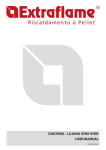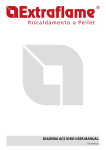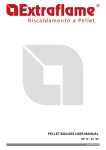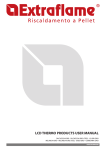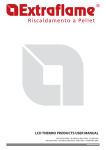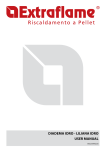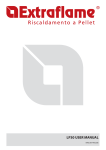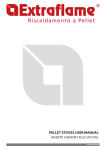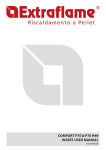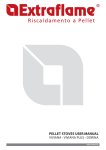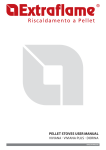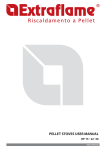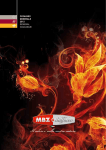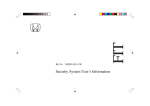Download DIADEMA ACS IDro USEr MANUAL
Transcript
DIADEMA ACS idro USER MANUAL ENGLISH ENGLISH/INGLESE ENGLISH We thank you for having chosen our company; our product is a great heating solution developed from the most advanced technology with top quality machining and modern design, aimed at making you enjoy the fantastic sensation that the heat of a flame gives, in complete safety. ENGLISH....................................................................................................................................................................................... 5 WARNINGS................................................................................................................................................................................... 5 SAFETY......................................................................................................................................................................................... 5 ROUTINE MAINTENANCE........................................................................................................................................................... 5 HYDRAULIC SYSTEM................................................................................................................................................................... 6 INSTALLATION AND SAFETY DEVICES................................................................................................................................................................................. 6 TYPE OF SYSTEM......................................................................................................................................................................... 6 SAFETY DEVICES FOR CLOSED VESSEL SYSTEM.............................................................................................................................................................. 7 DISTANCES OF SAFETY DEVICES ACCORDING TO THE STANDARD......................................................................................................................... 7 COMMISSIONING CHECKS......................................................................................................................................................... 7 AUTOMATIC THERMOSTATIC MIXER VALVE (MANDATORY).................................................................................................. 7 HYDRAULIC PLANT BASIC LAYOUT.......................................................................................................................................... 8 STOVE POSITIONING................................................................................................................................................................................................................... 9 INDEX REARMS........................................................................................................................................................................................ 9 DIADEMA ACS IDRO FEATURES................................................................................................................................................. 9 DEVICES.....................................................................................................................................................................................10 REFERENCE STANDARDS.........................................................................................................................................................10 GENERAL........................................................................................................................................................................................................................................11 INSTALLATION...........................................................................................................................................................................12 FUMES EXHAUST SYSTEM.......................................................................................................................................................13 GENERAL REQUIREMENTS......................................................................................................................................................................................................13 SMOKE DUCT................................................................................................................................................................................................................................14 CHIMNEY........................................................................................................................................................................................................................................16 CHIMNEY CAPS............................................................................................................................................................................................................................16 COMBUSTION PRODUCTS OUTLET QUOTA.....................................................................................................................................................................17 FUMES EXHAUST SYSTEM PRODUCT REQUIREMENTS...............................................................................................................................................17 TECHNICAL INSTALLATION DOCUMENTATION..............................................................................................................................................................18 PELLETS AND FEEDING............................................................................................................................................................19 ENGLISH 3 CHECKS AND PRECAUTIONS FOR FIRST IGNITION...............................................................................................................19 THE PELLET LOADING MOTOR DOES NOT WORK:.................................................................................................................................................19 CONTROL PANEL.......................................................................................................................................................................20 DISPLAY ICONS KEY...................................................................................................................................................................................................................20 GENERAL MENU........................................................................................................................................................................21 BASIC INSTRUCTIONS ..............................................................................................................................................................................................................21 THE REMOTE CONTROL............................................................................................................................................................22 ENABLE DELAYED SWITCH-OFF............................................................................................................................................................................................22 TYPE AND REPLACEMENT OF BATTERIES.........................................................................................................................................................................22 COMMISSIONING SETTINGS....................................................................................................................................................23 ADJUSTING TIME, DAY, MONTH AND YEAR......................................................................................................................................................................23 ADJUSTING LANGUAGE...........................................................................................................................................................................................................23 OPERATION AND LOGIC...........................................................................................................................................................24 INSTANT DOMESTIC HOT WATER PRODUCTION KIT............................................................................................................25 MODES............................................................................................................................................................................................................................................26 DHW ................................................................................................................................................................................................................................................26 HEATING.........................................................................................................................................................................................................................................26 PUFFER ..........................................................................................................................................................................................................................................26 ADDITIONAL ROOM THERMOSTAT.........................................................................................................................................27 ADDITIONAL ROOM THERMOSTAT FUNCTIONING WITH STBY ACTIVE...............................................................................................................27 ADDITIONAL ROOM THERMOSTAT FUNCTIONING WITH STBY DISABLED.........................................................................................................27 AUX.............................................................................................................................................................................................27 SET POWER ...................................................................................................................................................................................................................................28 SET TEMPERATURE.....................................................................................................................................................................................................................28 SET ADJUSTMENTS...................................................................................................................................................................28 BURN POT CLEANING................................................................................................................................................................................................................29 STAND - BY.....................................................................................................................................................................................................................................29 ENABLE CHRONO.......................................................................................................................................................................................................................29 PELLET ADJUSTMENT...............................................................................................................................................................................................................29 USER MENU...............................................................................................................................................................................30 SET CLOCK.....................................................................................................................................................................................................................................30 CHRONO.........................................................................................................................................................................................................................................31 ADJUSTING LANGUAGE...........................................................................................................................................................................................................32 DISPLAY..........................................................................................................................................................................................................................................32 RESET...............................................................................................................................................................................................................................................33 OTHER FUNCTIONS...................................................................................................................................................................33 AIR DISCHARGE...........................................................................................................................................................................................................................33 FIRST LOAD....................................................................................................................................................................................................................................33 CLEANING AND MAINTENANCE..............................................................................................................................................34 MAINTENANCE..........................................................................................................................................................................34 CLEANING AND MAINTENANCE BY THE USER................................................................................................................................................................34 ROUTINE MAINTENANCE PERFORMED BY QUALIFIED TECHNICIANS ..............................................................................37 DECOMMISSIONING (END OF SEASON)............................................................................................................................................................................37 DISPLAYS...................................................................................................................................................................................39 ALARMS.....................................................................................................................................................................................40 4 ENGLISH WARNINGS This instructions manual is an integral part of the product: make sure that it always accompanies the appliance, even if transferred to another owner or user, or if transferred to another place. If it is damaged or lost, request another copy from the area technician. This product is intended for the use for which it has been expressly designed. The manufacturer is exempt from any liability, contractual and extracontractual, for injury/damage caused to persons/animals and objects, due to installation, adjustment and maintenance errors and improper use. Installation must be performed by qualified staff, which assumes complete responsibility for the definitive installation and consequent good functioning of the product installed. One must also bear in mind all laws and national, regional, provincial and town council Standards present in the country in which the appliance has been installed, as well as the instructions contained in this manual. The Manufacturer cannot be held responsible for the failure to comply with such precautions. After removing the packaging, ensure that the content is intact and complete. Otherwise, contact the dealer where the appliance was purchased. All electric components that make up the product must be replaced with original spare parts exclusively by an authorised aftersales centre, thus guaranteeing correct functioning. SAFETY The generator must not be used by persons (including children) with reduced physical, sensory and mental capacities or who are unskilled persons, unless they are supervised and trained regarding use of the appliance by a person responsible for their safety. Children must be checked to ensure that they do not play with the appliance. Do not touch the generator when you are barefoot or when parts of the body are wet or damp. The safety and adjustment devices must not be modified without the authorisation or indications of the manufacturer. Do not pull, disconnect, twist electric cables leaving the stove, even if disconnected from the electric power supply mains. It is advised to position the power supply cable so that it does not come into contact with hot parts of the appliance. The power supply plug must be accessible after installation. Do not close or reduce the dimensions of the airing vents in the place of installation. The airing vents are essential for correct combustion. Do not leave the packaging elements within reach of children or unassisted disabled persons. The hearth door must always be closed during normal functioning of the product. When the appliance is functioning and hot to the touch, especially all external surfaces, attention must be paid Check for the presence of any obstructions before switching the appliance on following a prolonged period of inactivity. The generator has been designed to function in any climatic condition (even critical). In particularly adverse conditions (strong wind, freezing) safety systems may intervene that switch the generator off. If this occurs, contact the technical aftersales service and always disable the safety systems. In the event the flue catches fire, use suitable systems for suffocating the flames or request help from the fire brigade. This appliance must not be used to burn waste Do not use any flammable liquids for ignition During the filling phase do not put the bag of pellets to into contact with the product The majolicas are top quality artisan products and as such can have micro-dots, crackles and chromatic imperfections. These features highlight their valuable nature. Due to their different dilation coefficient, they produce crackling, which demonstrate their effective authenticity. To clean the majolicas, it is recommended to use a soft, dry cloth. If a detergent or liquid is used, the latter could penetrate inside the crackles, highlighting them. ROUTINE MAINTENANCE Based on Decree 22 January 2008 n°37 art.2, routine maintenance means interventions aimed at reducing degradation due to normal use, as well as dealing with accidental events entailing the need of first interventions, which however do not modify the structure of the system upon which one is intervening or its intended use according to the requirements laid down by the technical standards in force and by the manufacturer's use and maintenance manual. ENGLISH 5 HYDRAULIC SYSTEM Certain concepts referring to the Italian UNI 10412-2 (2009) Standard are described in this chapter. As previously described, when installing, all national, regional, provincial and town council Standards in force provided by the country in which the appliance has been installed must be complied with. TABLE OF DEVICES FOR CLOSED VESSEL SYSTEM, PRESENT AND NOT PRESENT IN THE PRODUCT Safety valve Pump control thermostat (managed by the water probe and board program) R R - Acoustic alarm activation thermostat R R Water temperature indicator (display) Pressure transducer with display - Acoustic alarm Automatic circuit breater switch (managed by board program) Pressure transducer with minimum and maximum pressure switch alarm Water overheating automatic circuit breaker (blocking thermostat) Circulation system (pump) Expansion system R R R R R During installation of the stove it is MANDATORY to adjust the system with a manometer in order to display the water pressure. INSTALLATION AND SAFETY DEVICES The installation, relative system connections, commissioning and inspection of correct functioning must be carried out perfectly, in total compliance with Standards in force, both national, regional and municipal, as well as these instructions. For Italy, installation must be carried out by professionally authorised staff (Ministerial Decree dated 22.01.08 n°37). The manufacturer declines all responsibility for damages to objects and/or persons caused by the system. TYPE OF SYSTEM There are two different types of system: Open vessel plant and closed vessel plant. The product has been designed and realised to work with closed vessel systems. J 6 CHECK THAT THE PRE-FILLING PRESSURE OF THE EXPANSION VESSEL IS 1.5 BAR. ENGLISH SAFETY DEVICES FOR CLOSED VESSEL SYSTEM According to the UNI 10412-2 (2009) Standard in force in Italy, the closed systems must have: safety valve, pump control thermostat, acoustic alarm activation thermostat, temperature indicator, pressure indicator, acoustic alarm, regulation automatic circuit breaker switch, automatic circuit breaker block switch (block thermostat), circulation system, expansion system, safety dissipation system incorporated with the generator with thermal safety valve (self-activated), whenever the appliance does not have a temperature self-adjustment system. DISTANCES OF SAFETY DEVICES ACCORDING TO THE STANDARD The temperature safety sensors must be in place on the machine at a distance no greater than 30 cm from the flow connection. Whenever the generators lack a device, those missing can be installed on the generator flow pipe, within a distance no greater than 1 m from the machine. COMMISSIONING CHECKS Before connecting the boiler: a) wash all system piping in order to remove any residues which might compromise the correct functioning of certain system components (pumps, valves, etc.). b) check to verify that the flue has adequate draft, is not narrowed and that other appliances do not discharge into the flue. This is to prevent unexpected power increases. Only after this control can the flue fitting be mounted between the boiler and the flue. A check of the connections with pre-existing flues is recommended. AUTOMATIC THERMOSTATIC MIXER VALVE (MANDATORY) It is required to create an adequate anti-condensation circuit that ensures a return temperature for the appliance of at least 55° C. The anti-condensation valve, for example, is applied in solid fuel boilers as it prevents the return of cold water in the heat exchanger. Routes 1 and 3 are always open and, together with the pump installed on the return, they guarantee water circulation inside the biomass boiler exchanger. A high return temperature allows efficiency improvement, reduces formation of smoke condensation and prolongs the life span of the generator. Valves on the market have different calibrations. The manufacturer advises use of model 55°c with 1" hydraulic connections. Once the valve calibration temperature is reached, route 2 is opened and the boiler water goes to the system via the flow. 3 2 1 Valve sold as an accessory (optional) ENGLISH 7 HYDRAULIC PLANT BASIC LAYOUT R T5 VMS T T1 TS M T2 B VB T3 T4 A 1 3 2 VMTA STBY AUX KEY A Combustion air inlet Ø 60mm B Smoke exhaust outlet Ø 120mm T1 3 bar safety valve T2 Boiler flow / output 1" T3 Boiler return / inlet 1" T4 Domestic cold water inlet 1/2 " T5 Domestic hot water outlet 1/2 " M Pressure Gauge T Thermometer TS Domestic terminals R Feed valve VB 1/2 " Balance valve VMTA Thermostatic mixer valve 55°C VMS Domestic water mixing valve IT IS RECOMMENDED TO CONSULT THE TEMPLATES MANUAL ON THIS WEBSITE FOR FURTHER INFORMATION RELATING TO THE HYDRAULIC CONNECTIONS, AIR INTAKE/FLUE EXHAUST AND DIMENSION SPECIFICATIONS OF THE PRODUCT IN QUESTION. 8 ENGLISH STOVE POSITIONING For correct product functioning, it is recommended to position it so that it is perfectly level, using a spirit level. REARMS The figures below illustrate the positions of the tank (85°C) and H2O (100°C) rearms. Contact the qualified technician if one of the rearms should be triggered, so as to verify the cause. 100°C 85°C STBY AUX DIADEMA ACS IDRO FEATURES DIADEMA ACS IDRO Water content of the thermo-product heat exchanger (l) 21 Volume of expansion vessel integrated in the thermo-product (l) 8 3 bar safety valve integrated in the thermo-product SI Minimum and maximum pressure switch integrated into the thermo-product SI Pump integrated into the thermo-product SI Pump max. head (m) 5 * * ENVISION A POSSIBLE ADDITIONAL EXPANSION VESSEL DEPENDING ON THE SYSTEM WATER CONTENT. 6 5 The diagram to the side illustrates the behaviour of the pump used on our thermo-products at the speeds that can be set. Head (m) 4 3 2 1 0 ENGLISH 0,0 0,5 1,0 1,5 Flow rate (m3/h) 2,0 2,5 9 DEVICES TERMS AND DEFINITIONS (in the relevant models) Aeration: Air renewal is required both for the disposal of the combustion products, and to prevent mixtures with a hazardous content of non-combusted gases. Door micro switch: With the door open, the operation of the burn pot cleaning system is blocked Closed hearth appliance: Appliance designed for operation with closed combustion chamber. Electronic pressure switch: in the event of inadequate pression, it sends the machine in alarm conditions Forced draught appliance: Appliance with ventilation in the fumes circuit and combustion with fumes flow at a positive pressure with respect to the environment. F 2.5 A 250 V fuse (stoves): protects the machine from violent current surges Chimney: Structure consisting in one or several walls containing one or several outflow airways. The purpose of this predominantly vertical element is to expel the combustion products at a convenient height from the ground. 85°C calibrated mechanical bulb with manual rearm: intervenes by blocking fuel feed if the pellet tank t° reaches the limit of 85°C. Rearm must be performed by qualified staff and/ or the manufacturer's technical after-sales assistance. Smoke duct: Component or components that connect the outlet of the heat generator to the chimney. Pellet tank temperature control probe: if the tank over-heats, the machine automatically modulates to return to normal temperature values Condensation: Liquid products which form when the fumes temperature is lower or equal to the water dew point. Mechanical air pressure switch: blocks the pellet in the event of insufficient depression REFERENCE STANDARDS The installation must be in compliance with: UNI 10683 (2012) heat generators fed with wood and other solid fuels: installation. The chimneys must be in compliance with: UNI EN 13063-1 and UNI EN 13063-2, UNI EN 1457, UNI EN 1806 in the event of non-metallic chimneys: EN 13384-1 (13384) chimneys. Thermal and fluid dynamic calculation methods. UNI EN 1443 (2005) chimneys: general requirements. UNI EN 1457 (2012) chimneys: clay/ceramic flue liners. UNI/TS 11278 (2008) Metal - chimneys/flue liners/flue ducts. UNI 7129 point 4.3.3 Fire Brigade provisions, local rules and regulations. NATIONAL, REGIONAL, PROVINCIAL AND TOWN COUNCIL REGULATIONS One must also bear in mind all laws and national, regional, provincial and town council Standards present in the country in which the appliance has been installed. 10 Chimney cap: Device that placed on the chimney outlet allows the dispersion of the combustion products even in presence of adverse weather conditions. Ducting pipe: Pipe made up of one or several predominantly vertical elements, specifically suitable for collecting and expelling the fumes, as well as to withstand the relative components and any condensate over time, suitable to be installed in a chimney, existing or new technical compartment, even in new buildings. Sealed installation: Installation of an appliance with sealed operation, so that all the air required for combustion is taken from outside. Maintenance: Set of procedures required to ensure and maintain safety and functionality over time and maintain the efficiency of the system within the prescribed parameters. Chimney system: Chimney installed using a combination of compatible components, manufactured or specified by a sole manufacturer whose product liability covers the entire chimney. Fumes exhaust system: Flue gas exhaust system, independent from the appliance made up of a smoke duct, chimney or individual flue and chimney cap. Radiation area: Area immediately in front of the hearth in which the radiant heat caused by combustion is diffused. Reflux area: Area beyond the extrados of the roof in which overpressure or depressions occur, which may affect the proper discharge of the combustion products. ENGLISH FUNCTIONAL OPERATIONS DIAGRAM State of the art installation and proper system operation include a series of activities: 1. Preliminary activities: Verification of the suitability of the power of the heat generator based on the characteristics of the system verification of the suitability of the installation site, verification of the suitability of the fumes exhaust system, verification of the suitability of the outside air inlets; 2. Installation: implementation of ventilation and connection to the outer air inlets, implementation and connection to the fumes exhaust system, assembly and installation, electric and hydraulic connections, installation of insulation, ignition and operation test, installation of finishings and coverings; 3. Issue of complementary documentation; 4. Inspection and maintenance. Other actions may be required in relation to specific requests of the competent authority. PRELIMINARY ACTIVITIES GENERAL Verification of compatibility of the system, of any restrictions required by local administrative regulations, special or conventional requirements resulting from condominium regulations, constraints, laws or administration deeds must precede any other assembly or installation operation. One must especially verify the suitability: of the installation premises, of the appliances already installed in the installation premises and in the adjacent and adjoining premises, also powered by different fuels, with particular reference to non-compliant installations. of the fumes exhaust system of the outside air inlets SUITABILITY OF THE FUMES EXHAUST SYSTEM Installation must be preceded by a compatibility test between the appliance and the fumes exhaust system, by verifying: the existence of documentation relating to the system; existence and content of the chimney plaque; suitability of the internal section of the chimney; absence of obstructions all along the chimney; predominantly vertical height and development of the chimney; existence and suitability of the chimney cap; distance of the outside wall of the chimney and of the smoke duct from combustible materials; chimney type and material; absence of other chimney connections. ENGLISH 11 INSTALLATION Installation in premises with fire hazards is forbidden. Installation in residential premises (except for sealed operation appliances) is also forbidden: in which there are liquid fuel-operated appliances with continuous or intermittent operation, which draw the combustion air in the room in which they are installed, or in which there are type B gas appliances intended for room heating, with or without production of domestic hot water and in adjacent and adjoining premises, or in which, in any case, the depression measured during installation between the internal and external environment is greater than 4 Pa Installations in bathrooms, bedrooms and studio flats Installation in bathrooms, bedrooms and studio flats is only allowed for sealed or closed hearth appliances with ducted combustion air taken from the outside. Installation premises requirements The support surfaces and/or points must have a suitable load-bearing capacity to support the weight of the appliance, of the accessories and coatings. The adjacent, side and rear walls and the supporting surface must be made of non-combustible material. Installation near combustible materials or those sensitive to heat is permitted as long as there is a suitable safety distance, which for pellet stoves is equal to: REFERENCES A B C INFLAMMABLE OBJECTS 200 mm 1500 mm 200 mm NON-INFLAMMABLE OBJECTS 100 mm 750 mm 100 mm Flue B figure 1 C Air inlet A Inspection figure 2 S S= floor protection In any case the temperature of the adjacent combustible materials must not reach a temperature equal to or greater than the room temperature increased by 65°C. The minimum volume of the premises in which to install the appliance must be greater than 15 m³. 12 ENGLISH VENTILATION AND AERATION OF THE INSTALLATION PREMISES Ventilation is deemed sufficient when the room is equipped with air inlets according to the table: Air inlet See figure 2 Appliance categories Reference standard Percentage of the net opening section with respect to the appliance fumes outlet section Pellet stoves UNI EN 14785 - 80 cm² Boilers UNI EN 303-5 50% 100 cm² Minimum net opening value of the ventilation duct In any case ventilation is deemed sufficient when the pressure difference between the external and internal environment is equal to or less than 4 Pa. In the presence of type B gas appliances with intermittent operation not intended for heating, they must have their own aeration and/or ventilation opening. The air inlets must meet the following requirements: they must be protected with grids, metal mesh, etc., but without reducing the net useful section; they must be made so as to make the maintenance operations possible; positioned so that they cannot be obstructed; The flow of clean, uncontaminated air can also be obtained from a room adjacent to that of installation (indirect aeration and ventilation), as long as the flow takes place freely through permanent openings communicating with the outside. The adjacent room cannot be used as a garage, warehouse of combustible material or for any other activity with a fire hazard, bathroom, bedroom or common room of the building. FUMES EXHAUST SYSTEM GENERAL REQUIREMENTS The heat generator works in a vacuum and has an output fan for fume extraction. Each appliance must be connected to a suitable fumes exhaust system and ensure adequate dispersion of the combustion products into the atmosphere. The combustion products must discharged above the roof. Direct discharge from the wall or towards closed spaces is forbidden, even with clear skies. In particular, it is forbidden to use flexible and extendible metal pipes. The chimney should only receive the exhaust of the smoke duct connected to the appliance; collective flues or conveying exhausts from hoods above cooking appliances of any kind, or exhausts from other generators into the chimney itself or smoke duct are not allowed. The smoke duct and the chimney must be connected with a continuity solution, in order to prevent the chimney from resting on the appliance. It is forbidden to have other air supply channels and pipes for plant engineering transit inside the fumes exhaust systems, especially if over-sized. The components of the fumes exhaust system must be chosen in relation to the type of appliance to be installed in compliance with: in the event of metal chimneys, UNI/ TS 11278, with particular attention to what is stated in the specification; in the event of non-metallic chimneys: UNI EN 13063-1 and UNI EN 13063-2, UNI EN 1457, .-UNI EN 1806; considering especially: temperature class; pressure class (fumes seal) at least equal to the seal required for the appliance; moisture resistance (resistance to condensation); class or level of corrosion and specification of the materials constituting the inner wall in contact with the fumes. soot fire resistance class; minimum distance from combustible materials Where due to high efficiency a pellet stove has fumes at a temperature of less than 160°C + ambient (see technical data) it must be resistant to moisture. The installer of the fumes exhaust system, once the installation is complete and the relevant checks and inspections have been made, must fix the chimney plaque supplied by the manufacturer with the product in a visible manner, near the fireplace, and which must be completed with the following information: ENGLISH 13 nominal diameter; distance from combustible materials, indicated in millimetres, followed by the arrow and flame symbol; installer data and date of installation. Every time one must cross combustible materials, the following indications must be complied with: a a a a a a b.1 b.1 b.1 b b b SYMBOL DESCRIPTION QUOTA[MM] b Minimum distance of combustible materials from the intrados of the framework/floor/wall 500 b.1 Minimum distance of combustible materials from the extrados of the framework/floor 500 a Minimum distance from combustible materials defined by the manufacturer G(xxx) The single wall pipes are indicated in white. The insulated double wall chimney systems are indicated in grey. One can disregard the quota only in the event of using an appropriate heat protection screen (for example: wall plate) to protect the intrados of the framework/floor SMOKE DUCT General requirements The smoke ducts must be installed in compliance with the following general requirements: be equipped with at least one sealed outlet for eventual fumes sampling; they must be insulated if they cross through rooms that are not to be heated or outside the building; they must not cross rooms in which the installation of combustion appliances is forbidden, nor in other premises compartmentalised against fire or with a fire hazard, nor in rooms and/or areas that cannot be inspected; they must be installed so as to allow normal thermal expansion; they must be fitted to the opening of the chimney without protruding inwards; the use of flexible metal pipes to connect the appliance to the chimney is not allowed; Chimney Chimney Incorrect Correct OK OK 14 ENGLISH counter-slope sections are not allowed; the smoke ducts must have, along their entire length, a diameter that is no less than that of the attachment of the appliance exhaust pipe; any section changes are allowed only on the inlet to the chimney; they must be installed so as to limit the formation of condensation and prevent their release from the joints; they must be positioned at a distance no less than that indicated in the product specifications from combustible materials; the smoke channel/duct must allow to collect the soot and to be cleaned using a swab and inspected after being disassembled, or through inspection openings when not accessible from inside the appliance. ADDITIONAL REQUIREMENTS FOR APPLIANCES FITTED WITH AN ELECTRIC FAN FOR FUMES EXPULSION For the heat generator appliances equipped with electric fan for expelling fumes, the instructions below must be followed: The horizontal sections must have a minimum upward slope of 3% The length of the horizontal section must be minimal and, in any case, no longer than 3 metres The number of direction changes including the one due to the use of the "T" element must not be more than 4. EXAMPLES OF CORRECT CONNECTION TO THE CHIMNEY Installation with internal - external flue Installation with internal flue Protection from rain and wind Protection from rain and wind Insulated flue Insulated flue Condensation-proof "T" fitting with inspection plug Insulated condensationproof "T" fitting with inspection plug IT IS NOT RECOMMENDED TO INSTALL A 90° BEND AS THE FIRST INITIAL PART, SINCE THE ASH WOULD BLOCK THE PASSAGE OF THE FUMES IN A SHORT TIME, CAUSING PROBLEMS TO THE GENERATOR DRAUGHT.: Ash deposited in the 90° bend Ash deposited in the 90° bend ENGLISH 15 EXAMPLES OF CORRECT CONNECTION TO THE CHIMNEY Protection from rain and wind Protection from rain and wind Steel plate, airtight Max 3 mt 3 - 5% "T" fitting with inspection plug "T" fitting with inspection plug Insulated "T" fitting with inspection plug It is mandatory to use airtight pipes. CHIMNEY In addition to the general requirements, the chimneys for releasing combustion products into the atmosphere must: operate under negative pressure (operation under positive pressure is not allowed); have a preferably circular internal section; square or rectangular sections must have rounded corners with a radius of no less than 20 mm (hydraulically equivalent sections may be used, as long as the ratio between the longer side and the shorter side of the rectangle, which circumscribes the section, is in any case no greater than 1.5); be designed for fumes be designed for fumes expulsion; be predominantly vertical and have no narrowing along their entire length; have no more than two direction changes with a slope angle no greater than 45°; be fitted with, in the event of operating in damp conditions, a device for reflux drainage (condensation, rainwater); Ducted system A ducted system can be installed with one or more ducts, operating only with negative pressure with respect to the environment. The flexible hose compliant with UNI EN 1856-2, with T400-G characteristics, meets the requirements. CHIMNEY CAPS The chimney caps must meet the following requirements: they must have a useful outlet section no less than double of that of the chimney/ducted system on which it is installed; they must be adapted in order to prevent the penetration of rain and snow in the chimney/ducted system; they must be built so that, in the event of winds coming from all directions and from any angle, the expulsion of combustion products is in any case ensured; they must be free from mechanical intake aids. 16 ENGLISH COMBUSTION PRODUCTS OUTLET QUOTA The outlet quota is determined by measuring the minimum height between the roof covering and the lower point of the fumes expulsion section into the atmosphere; this quota must be outside the reflux area and at an adequate distance from obstacles which hinder or make the expulsion of the combustion products difficult or from openings or accessible areas. Reflux area The outlet quota must be outside the reflux area calculated according to the indications below. Near the ridge one considers the lowest between the two. Buffer area for outlet quota a 90° ß c Clear area for outlet quota above the roof slope ( ß >10°) REFERENCE DESCRIPTION CLEAR AREA (MM) c Distance measured at 90° from the roof surface 1300 a Height above the ridge of the roof 500 The outlet of a chimney/ducted system must not be near obstacles that may create turbulence areas and/or prevent proper expulsion of combustion products and maintenance operations to be carried out on the roof. Verify the presence of other chimney caps or skylights and dormers. FUMES EXHAUST SYSTEM PRODUCT REQUIREMENTS Temperature class In the event of a pellet appliance, temperature classes below T200 are not allowed. Soot fire resistance class The fumes exhaust system interlocked with appliances supplied by solid fuels require soot fire resistance, and the specification must be indicated by the letter G followed by the distance from combustible materials in millimeters (XX) (in compliance with UNI EN 1443) . In the event of pellet appliances, the fumes exhaust systems must be airtight; if double designation elements are used (G and O, with or without seal elastomer) for connecting the appliance to the chimney, one must comply with the minimum distance XX in millimeters, indicated for designation G; in the event of fire due to soot, one must ensure the restoration of the initial conditions (by replacing the gaskets and damaged items and cleaning those remaining in use). Ignition tests Operation of the appliance must be verified with an ignition test, i.e.: for mechanical feed appliances, one must complete the ignition test, verify proper operation for at least the next 15 minutes and adjust the switch-off; For appliances installed in a hot water heating system (closed fireplaces, thermo-stoves), testing must also extend to the entire hydraulic circuit. ENGLISH 17 Coverings and finishings The coverings and finishings must only be applied after having verified the proper operation of the appliance according to the indicated modalities TECHNICAL INSTALLATION DOCUMENTATION When installation is complete, the installer must provide the owner or person acting for him, according to the legislation in force, with the declaration of conformity, supplied with: 1) the use and maintenance manual of the appliance and of the system components (such as for example, the smoke ducts, chimney, etc.); 2) photocopy or photograph of the chimney plaque; 3) system booklet (where applicable). The installer must ask to be issued with a receipt stating that the documentation has been provided, and must keep it with a copy of the technical documentation relating to the installation. Installation performed by several parties If the individual installation steps are carried out by different parties, each must document the work carried out for the customer and the for the operator working on the next step. INSPECTION AND MAINTENANCE Frequency of operations Maintenance of the heating system and of the appliance must be carried out on a regular basis according to the table below: TYPE OF APPLIANCE INSTALLED <15kW (15- 35) kW Pellet operated appliance 1 year 1 year Water operated appliances (closed fireplaces, thermo-stoves, thermo-kitchens) 1 year 1 year Boilers 1 year 1 year 4 t of fuel used 4 t of fuel used Fumes exhaust system For further details refer to the "cleaning and maintenance" chapter. Inspection and maintenance report At the end of the inspection and/or maintenance operations, a report must be issued and released to the owner, or person acting for him, who must confirm its receipt in writing. The report must indicate the situations encountered, the action taken, any components replaced or installed and any comments, recommendations and requirements. The report must be kept with the relative documentation. In the inspection and maintenance report one must mention: anomalies detected that cannot be removed, which pose a risk to the safety of the user or serious damage to building; components that have been tampered with. If anomalies as per above were detected, the owner, or person acting for him, must be warned in writing, in the maintenance report, to refrain from using the system until the safety conditions have been fully restored. The inspection and maintenance report must include the main information of the technician or company who performed the inspection and/or maintenance operations, with their contact details, date of intervention and the signature of the operator. 18 ENGLISH PELLETS AND FEEDING Pellets are made by applying high pressure to sawdust, or wood waste products (not containing paint) from sawmills, carpentry and other activities related to processing and working with wood. Given that it does not use any glue to hold it together this type of fuel is completely environmentally friendly. In fact the compactness of the pellets over time is guaranteed by a natural substance found in the wood itself: wood coal. In addition to being an environmentally friendly fuel in that it pushes wood residues to the limits pellets also have technical advantages. While wood has a calorific value of 4.4kWh/kg. (with 15% humidity after around 18 months of seasoning) the calorific value of pellets is 5 kWh/kg. Pellet density is 650kg/m3 and the water content is equal to 8% of its weight. For this reason they do not require seasoning in order to arrive at a sufficiently adequate degree of heat yield. The pellets used must comply with the characteristics described by the following standards: EN PLUS - UNI EN 14961 - 2 (UNI EN ISO 17225-2) class A1 or A2 The manufacturer always recommended using pellets with a diameter of 6 mm with its products. PELLET STORAGE In order to ensure problem-free combustion pellets must be stored in a dry place. Open the tank lid and load the pellets using a scoop. THE USE OF EXPIRED PELLETS OR ANY OTHER MATERIAL WILL AFFECT THE FUNCTIONALITY OF YOUR GENERATOR AND MAY LEAD TO THE TERMINATION OF THE WARRANTY AND CESSATION OF ANY ACCOMPANYING RESPONSIBILITY ON THE PART OF THE MANUFACTURER CHECKS AND PRECAUTIONS FOR FIRST IGNITION IMPORTANT! IN ORDER FOR THE GENERATOR TO WORK PROPERLY, THE HYDRAULIC SYSTEM’S PRESSURE MUST BE BETWEEN 0.6 AND 2.5 BAR. If the pressure detected by the digital pressure switch is below 0.6 or above 2.5 bar, it triggers a boiler alarm. Bringing the water pressure within the standard values, it is possible to reset the alarm by pressing the button /1 for 3 seconds (The alarm can be reset only if the fumes motor has stopped and 15 minutes have elapsed from the display of the alarm) THE PELLET LOADING MOTOR DOES NOT WORK: Due to the filling of the system, it is normal that there is air inside the circuit. During the 1st ignition cycle, water movement causes the displacement of air bubbles and their out-flow from the automatic vents out of the system. This can cause the pressure to drop and activate the minimum pressure switch, which stops the motor that transports the pellets and, therefore, the heat generator. Vent out the system, if necessary even multiple times, to remove the air, and reload it if the pressure is too low. It is not a malfunction, but a normal occurrence due to its filling. After filling, the plumber must always thoroughly vent the system, using the special vents in the circuit and running the "air breather" function on the machine. (After the first ignition and with a cold machine, re-activate the function "air breather" - see chapter "OTHER FUNCTIONS”) BULB THERMOSTATS - RESET: Check by pressing the reset buttons (85 - 100°C) located on the back of the appliance, before contacting a technician (see section RESET). ENGLISH 19 CONTROL PANEL BUTTON ON/OFF DISPLAY OF VARIOUS TEXT MESSAGES TO ACCESS THE MENU OFF OPERATION POWER ADJUSTMENT TEMPERATURE SETTING DISPLAY ICONS KEY 20 Indicates the receipt of the radio signal On = during radio communication Off = no radio communication Flashing = serial port excluded Indicates the stove modulation On = the stove is working at the set power Flashing = the power at which the stove is working is different to the power set, the stove is modulating (for various reasons) Indicates the presence of an alarm. On: indicates the presence of an alarm Off: indicates the absence of alarms Flashing: indicates the deactivation of the depression sensor. It indicates weekly programming functioning Indicator on = weekly programming active Indicator off = weekly programming disabled Indicates the water temperature status Off = the T° read by the probe is above the set temperature On = the T° read by the probe is below the set temperature Indicates the contact of the external additional thermostat Contact closed: the contact of the external additional thermostat is closed and the STBY function is disabled. Contact open: the contact of the external additional thermostat is open and the STBY function is disabled. Flashing with contact closed: the contact of the external additional thermostat is closed and the STBY function is activated Flashing with contact open: the contact of the external additional thermostat is open and the STBY function is activated It indicates functioning of the fumes motor. Off = flue gas motor deactivated On = flue gas motor active Flashing = breakdown (contact technical after-sales service) It indicates the summer / winter function Off: Activates the winter function On: Activates the summer function Not used Indicates the DHW request Off = DHW satisfied, pump off Flashing : the DHW request exists but the work conditions are not satisfied, pump off On : the DHW is in request mode and the work conditions are satisfied, pump on It indicates functioning of the pellet feed motor Off = pellet feed motor deactivated On = pellet feed motor active Indicates the heating request Off : heating satisfied, pump off Flashing : the heating request exists but the work conditions are not satisfied, pump off On : the heating is in request mode and the work conditions are satisfied, pump on It indicates pump operation Off = pump deactivated On = pump active Flashing = the safety device is active (H2O temperature > 85°C) Indicates the puffer request, if active. Off : puffer satisfied, pump off Flashing : the puffer request exists but the work conditions are not satisfied, pump off On : the puffer is in request mode and the work conditions are satisfied, pump on ENGLISH GENERAL MENU 2 1 6 4 OFF 3 GO BACK - EXIT 1 5 6 2 3 PARAMETER SCROLLING: NEXT (2) ; PREVIOUS (3) 4 5 MODIFY SETTINGS DATA: INCREASE (4); DECREASE (5) 6 CONFIRM - ACCESS MENU SET POWER 2 SET TEMPERATURE 6 SET ADJUSTMENTS 6 STATUS 6 SET H2O 2 2 2 2 2 STOVE STATUS 2 2 2 BOILER STATUS 2 SET BOILER MIN STAND - BY 2 2 SET PUFFER MAX ENABLE CHRONO 2 2 HEAT. STATUS SET PUFFER MIN PELLETS 2 PUFFER STATUS SUMMER/WINTER 2 2 USER MENU SET BOILER MAX BURN POT CLEANING ENABLE/DISABLE BOILER CHRONO BIOMASS BIOMASS/AUX AUX 6 SET CLOCK 2 2 SET CHRONO 2 TECHNIC SET LANGUAGE (RESERVED TO THE QUALIFIED TECHNICIAN) 2 DISPLAY KEY LOCK - BRIGHTNESS 2 RESET 2 BOILER CHRONO BASIC INSTRUCTIONS The following recommendations must be followed the first times the stove is ignited: Faint smells may be produced due to the drying of the paints and silicones used. Do not remain in the environment for long periods. Do not touch the surfaces as they could still be unstable. Air the room well several times. The hardening of the surfaces is terminated after several heating processes. This appliance must not be used to burn waste. Before lighting the stove, the following points must be verified: The hydraulic system must be completed in compliance with the guidelines of the regulations and the manual. The tank must be full of pellets The combustion chamber must be clean The burn pot must be completely free and clean Check the hermetic closure of the fire door and the ash drawer Check that the power supply cable is connected correctly The bipolar switch in the rear right part must be positioned on 1. DO NOT USE ANY INFLAMMABLE LIQUIDS FOR IGNITION! DO NOT ALLOW THE BAG OF PELLETS TO COME INTO CONTACT WITH THE BOILING HOT STOVE DURING THE FILLING PHASE! IN THE EVENT OF CONTINUOUS NO IGNITION, CONTACT AN AUTHORISED TECHNICIAN. ENGLISH 21 THE REMOTE CONTROL All that can normally be implemented through the LCD can be adjusted using the remote control. The table below provides a detailed description of the various functions: 1 2 4 6 3 7 5 9 8 11 14 10 13 12 INFO 15 16 1 ON / OFF Pressing the key for three seconds, the stove will switch on or off 2 POWER INCREASE Pressing the key will increase the operating power 3 POWER DECREASE Pressing the key will decrease the operating power 4 T° INCREASE The set temperature can be increased by pressing this key 5 T° DECREASE The set temperature can be decreased by pressing this key 6 ENABLE/DISABLE CHRONO Pressing the key once will enable or disable the chrono 7 ENABLE DELAYED SWITCH-OFF The delayed switch-off can be set by pressing this key. For example, if the stove is set to switch-off in an hour, it shall switch-off automatically once the set time elapses, displaying the countdown every minute for delayed automatic shutdown. 8 MENU This key allows to access the user and technical menu (the technical menu is reserved for assistance) 9 INCREASE The set temperature can be increased by pressing this key 10 ESC KEY The key allows the user to exit any program or display and returns to the main menu without saving the data 11 BACK The key returns to the display of the various menus 12 CONFIRMATION KEY This key confirms the adjustments made during the user menu programming phase 13 FORWARD The key moves forward in the various menus 14 ENABLE F1 FUNCTION Pre-set key for future applications 15 DECREASE The key decreases the value to be set 16 STOVE STATUS Pressing this key will display the general status of the stove Important note: the numbers shown on the remote control are purely indicative and are not present on the remote control supplied with the product. TYPE AND REPLACEMENT OF BATTERIES The batteries are housed in the lower part of the remote control. To replace them, remove the battery holder (as indicated in the figure at the back of the remote control), remove or insert the battery according to the symbol on the remote control and on the battery itself. For operation, 1 CR2025, 3V lithium buffer battery is required. IF THE REMOTE CONTROL IS OFF BECAUSE IT HAS NO BATTERIES, THE STOVE CAN BE CONTROLLED FROM THE CONTROL PANEL ON TOP OF IT. WHILE REPLACING THE BATTERY, PAY ATTENTION TO THE POLARITY BY OBSERVING THE SYMBOL ON THE INSIDE COMPARTMENT OF THE REMOTE CONTROL. The batteries used contain metals harmful for the environment. They must therefore be disposed of separately in appropriate containers. 22 ENGLISH COMMISSIONING SETTINGS Once the power cable at the back of the stove has been connected, move the switch, also located on the back, to (I). The switch at the back of the stove powers the stove board. The stove remains off and a first screen appears on the panel reading OFF. ADJUSTING TIME, DAY, MONTH AND YEAR Set clock allows to adjust the time and date CONTROLS PROCEDURE Press key 6 and SET POWER will appear Press key 2 several times until USER MENU is displayed Confirm using key 6 SET CLOCK will appear. Confirm using key 6 Use key 4 or 5 to select the day Proceed by pressing key 2 Use the same procedure: 4 or 5 to set and key 2 to move forward; to adjust the hours, minutes, day, month and year Press key 1 several times to confirm and exit the menu SET CLOCK DAY MON, TUE, WED, ...SUN HOURS 0...23 MINUTES 00...59 DATE 1...31 MONTH 1...12 YEAR 00...99 ADJUSTING LANGUAGE It is possible to select the preferred language to display the various messages. CONTROLS PROCEDURE Press key 6 and SET POWER will appear. Press key 2 several times until USER MENU is displayed Confirm using key 6 SET CLOCK will appear. Press key 2 until SET LANGUAGE appears Confirm using key 6 Select the language using key 4 or 5. Press key 1 several times to confirm and exit the menu SET LANGUAGE ITALIAN ENGLISH LANGUAGE GERMAN FRENCH SPANISH BURN POT UPPER DIVIDER IT IS FORBIDDEN TO USE THE APPLIANCE WITHOUT THE DIVIDER AND/ OR GLASS PROTECTION (SEE THE FIGURE TO THE SIDE). ITS REMOVAL JEOPARDISES THE SAFETY OF THE PRODUCT AND IMMEDIATELY VOIDS THE WARRANTY PERIOD. IN THE CASE OF WEAR OR DETERIORATION REQUEST AFTER-SALES ASSISTANCE FOR REPLACEMENT OF THE PART (REPLACEMENT THAT IS NOT UNDER GUARANTEE AS THE COMPONENT IS SUBJECT TO WEAR). CLEAN CHECK UP 1 - 2 J SHOULD THE ALARM "CLEAN CHECK UP" BE TRIGGERED, MAKE SURE THAT THE BOTTOM OF THE BURN POT IS FREE FROM RESIDUES OR SCALING. THE HOLES ON THE SIDE OF THE BURN POT (SEE FIGURE TO THE SIDE) MUST BE COMPLETELY CLEAR, TO ENSURE PROPER COMBUSTION. (SEE CHAPTER "CLEANING UNDER USER'S RESPONSIBILITY") ONE CAN USE THE "PELLET FEED ADJUSTMENT" FUNCTION TO ADJUST THE COMBUSTION ACCORDING TO THE DESCRIBED REQUIREMENTS. IF THE ALARM PERSISTS AND THE ABOVE LISTED CONDITIONS HAVE BEEN CHECKED, CONTACT THE QUALIFIED AFTER-SALES ASSISTANCE CENTRE. BURN POT HOLES ENGLISH 23 OPERATION AND LOGIC OFF IGNITION Once the points listed previously have been checked, press key 1 for three seconds to ignite the stove. 15 minutes are available for the ignition phase. After ignition and having reached the control temperature, the stove interrupts the ignition phase and passes to STARTING. STARTING During the start-up phase, the stove stabilises combustion, increasing it progressively, to then start ventilation and pass on to WORK. WORK During the work phase, the stove reaches the set power; see following item. SET POWER ADJUSTMENT Set the operating power (from 1 to 5) . Power 1 = minimum level - Power 5 = maximum level. SET H2O TEMPERATURE ADJUSTMENT Set the boiler temperature between 65 - 80°C . PUMP OPERATION The pump activates water circulation when the t° of the water inside the stove reaches 60°C. As the pump always functions above 60°, an always open heating area is recommended to make product functioning homogenous, preventing overheating blocks. Normally this area is defined “Safety zone”. BURN POT CLEANING At pre-set intervals the stove performs burn pot cleaning, switching the machine off. When the cleaning phase is finished, the stove will re-start automatically and continue its work going back to the power level selected. MODULATION and H-OFF As the water temperature approaches the set point, the boiler starts to modulate automatically bringing itself to the minimum power. If the temperature increases beyond the set point, it will automatically switch off indicating H-OFF and will automatically go back on when the temperature drops below the set point. SWITCH-OFF Press key 1 for three seconds. When the operation has been performed, the appliance automatically enters the switch- off phase, blocking the supply of pellets. The flue gas exhaust motor will remain on until the stove temperature has dropped below the factory parameters. RE-IGNITION The stove can only be re-ignited automatically or manually when the cooling cycle conditions and the preset timer have been satisfied. NO IGNITION J 24 FIRST IGNITION COULD EVEN FAIL AS THE AUGER IS EMPTY AND IS NOT ALWAYS ABLE TO LOAD THE BURN POT WITH THE REQUIRED AMOUNT OF PELLETS ON TIME TO REGULARLY START THE FLAME. IF THE PROBLEM OCCURS AFTER ONLY A FEW MONTHS WORKING, CHECK THAT ROUTINE CLEANING STATED IN THE STOVE BOOKLET, HAS BEEN CARRIED OUT CORRECTLY. ENGLISH INSTANT DOMESTIC HOT WATER PRODUCTION KIT The thermo-stove is equipped with a kit for the production of domestic hot water consisting of a plate heat exchanger, a motorised diverter valve and a flow switch. Domestic water production = 11 l/ min (Δt 30°C) In absence of a request for domestic water, the heat generator heats the system water. In the event of a request for domestic water, the power of the generator is all used to produce domestic hot water (heat is not supplied to the heating system). In order to ensure proper operation in the domestic mode, the thermo-stove must be switched on, in steady state conditions and in operation. If the heat generator is in the H-OFF, T-OFF, STAND-BY, FINAL CLEANING and OFF conditions, it cannot supply heat for the production of hot water. In the H-OFF, T-OFF conditions, the stove is switched off because it has satisfied all heat requests, in this case a request for domestic water will make the stove switch on again but one must wait for the time required for it to reach steady state conditions. In the event of STAND-BY, the stove is switched off because it has satisfied the additional thermostat (STBY clamp), in this case a request for domestic water will not make the stove switch on again until the additional thermostat is in request conditions because the contact has priority over any request. Even in this case one must wait for the time required for steady state conditions. Avoid sampling hot water with very limited flow rates. Flow rates below 3 litres per minute can make the thermo-stove switch from the OPERATION state to the H-OFF state with consequent appliance shutdown. It is recommended to always leave a heating zone open in order to ensure the dissipation of any excess heat produced by the thermo-stove. In order to prevent burns, one must fit a thermostatic mixing valve, in order to limit the temperature of the domestic water sent to the utilities. One must provide a suitable water filtration and softening system according to the specific hardness of the water in the place where the heat exchanger is installed. The excessive deposit of limescale, as well as reducing the efficiency of the plate heat exchange, can compromise its operation. Replacement of the plate heat exchanger in the event of excessive fouling it not covered by the warranty. ENGLISH 25 The kit for the production of domestic hot water (plate heat exchanger, motorised diverter valve and flow switch) is controlled by a board integrated in the stove (system expansion board kit), which allows various hydraulic configurations up to a maximum of four heating zones, a puffer and an auxiliary boiler. I4A I4B I5 I6 I4A I4B I7 NF Neutral and phase OUT1/N 230 V 50 Hz output heating area 1 (max. 5A) OUT2/N 230 V 50 Hz output heating area 2 (max. 5A) OUT3/N 230 V 50 Hz output heating area 3 (max. 5A) OUT4/N 230 V 50 Hz output heating or puffer pump area 4 (max 5 A) 05NC/N 230 V 50 Hz output (max. 5A) normally closed for DHW 05NO/N 230 V 50 Hz output (max. 5A) normally open for DHW O6 NO/O6C auxiliary output normally open O6 NC/O6C auxiliary output normally closed I1/GND area 1 input (dry contact) I2/GND area 2 input (dry contact) I3/GND area 3 input (dry contact) I4A/GND area 4 input (dry contact) I4B/GND Future preparation I5/GND boiler / heat exchanger probe inlet I6/GND upper puffer probe inlet I7/GND lower puffer probe inlet OC power line connection (+ = red, - = black) MODES SUMMER - WINTER: the mode allows setting SUMMER or WINTER operation. In the SUMMER mode the room thermostats relating to the heating system and the puffer are always satisfied; the thermostove works to satisfy the DHW. In WINTER mode, all requests are considered (DHW, heating system and puffer) DHW DHW is controlled via the integrated instantaneous DHW exchanger (PH11=OFF) and always has priority over all other requests. HEATING The activation of the outputs relating to heating is affected by the operating modes (Summer/Winter) and by the presence or absence of the puffer. With the puffer deactivated, the outputs are activated when there is a request and the temperature of the water in the boiler is hot enough. With the puffer activated, the outputs are activated when there is a request and the temperature of the puffer is hot enough. One can enable the 4th Heating Zone. By setting parameter PH13 on “1”. To activate the puffer contact the dealer. (Default setting PH13=0 = disabled) PUFFER With the puffer active (set PH12=ON) the thermo-stove operates to satisfy the requests of the puffer and DHW (always priority). Default setting: PH12= OFF - disabled To activate the puffer contact the dealer. ATTENTION: THE PRODUCTION OF DHW IS ALREADY INTEGRATED IN THE MACHINE. THE PRODUCTION OF DOMESTIC HOT WATER IS ONLY ENSURED WHEN THE STOVE IS SWITCHED ON (OPERATING) OTHERWISE ONE MUST WAIT FOR THE STOVE TO SWITCH ON. IN THE EVENT THE OPTIONAL INPUTS ARE USED (PUFFER OR HEATING) OF THE MACHINE IS IN THE FOLLOWING STATE: TOFF, HOFF OR STBY (REQUESTS SATISFIED) ONE MUST WAIT FOR THE MACHINE TO SWITCH ON AGAIN! 26 ENGLISH ADDITIONAL ROOM THERMOSTAT N.B. : Installation must be performed by an authorised technician There is a possibility to thermostat a room adjacent to the room where the stove is positioned: just connect a thermostat following the procedure described in the next step (it is recommended to position the optional mechanical thermostat at a height of 1.50 m from the floor). Stove functioning with the external thermostat connected in the STBY clamp can be different on the basis of the activation or disabling of the STBY function. The STBY clamp leaves the factory jumpered, therefore it is always with closed contact (on request). ADDITIONAL ROOM THERMOSTAT FUNCTIONING WITH STBY ACTIVE When the STBY function is activated, the LED flashes. When the contact or external thermostat is satisfied (open contact / temperature reached), the stove will switch off. As soon as the contact or external thermostat switches to the "not satisfied" status (closed contact/temperature to be reached) it will re-ignite. N.B.: stove operation depends on the temperature of the water inside the stove and relative factory setting restrictions. If the stove is in H OFF (water temperature reached), any additional contact or thermostat request will be ignored. ADDITIONAL ROOM THERMOSTAT FUNCTIONING WITH STBY DISABLED When the STBY function is disabled, the LED is fixed. When the contact or external thermostat is satisfied (open contact / temperature reached), the stove will go to minimum. As soon as the contact or external thermostat switches to the "not satisfied" status (closed contact / temperature to be reached) the stove will start to work again at the pre-set power. N.B.: stove operation depends on the temperature of the water inside the stove and relative factory setting restrictions. If the stove is in H OFF (water temperature reached), any additional contact or thermostat request will be ignored. ADDITIONAL ROOM THERMOSTAT INSTALLATION Switch the appliance off using the master switch positioned on the rear of the stove. Remove the plug from the socket. Refer to the electrical diagram to connect the two thermostat cables onto the relative clamps positioned on the rear of the machine, one is red and the other one is black (STBY clamp). AUX Connection reserved for Extraflame conveyed waves accessories. Contact the dealer for further details STBY AUX STBY AUX J ENGLISH THE STBY AND AUX CLAMPS, FOUND AT THE BACK OF THE STOVE CAN BE NOTED IN THE DIAGRAM TO THE SIDE 27 SET POWER The following menu allows to set the power. Minimum power 1, maximum power 5. CONTROLS PROCEDURE Press key 6 and SET POWER will appear. Confirm using key 6 The POWER will be displayed. Press 4 to increase the setting and 5 to decrease it. Press key 6 to confirm and key 1 to return to the previous menus up to the initial status SET TEMPERATURE The following menu allows the boiler temperature to be set The possible settings are: 65 - 80°C. CONTROLS PROCEDURE Press key 6 and SET POWER will appear. Press key 2 several times until SET TEMPERATURE is displayed. Confirm using key 6 Press 4 to increase the setting and 5 to decrease it. Press key 6 to confirm and key 1 to return to the previous menus up to the initial status SET BOILER TEMPERATURE CANNOT BE ACTIVATED N.B.: DIADEMA ACS FEATURES AN INSTANTANEOUS HEAT EXCHANGER FOR THE PRODUCTION OF DOMESTIC HOT WATER AND IT IS NOT POSSIBLE TO SET THE BOILER TEMPERATURE SET PUFFER TEMPERATURE N.B.: the screen is not displayed if the puffer is disabled CONTROLS PROCEDURE Press key 6 Press key 2 until SET TEMPERATURE is displayed. Confirm using key 6 Press key 2 until SET PUFFER MAX is displayed (adjust using keys 4-5) Press key 2 until SET PUFFER MIN is displayed (adjust using keys 4-5) Press key 6 to confirm - press key 1 several times to exit the menu SET ADJUSTMENTS continues on next page 28 ENGLISH BURN POT CLEANING The menu allows to increase the frequency of the automatic burn pot cleaning. CONTROLS PROCEDURE Press key 6 and SET POWER will appear. Press key 2 several times until SET ADJUSTMENTS is displayed. Confirm using key 6 "BURN POT CLEANING" will appear. To increase the automatic cleaning frequency press 4. To go back to standard values (00) decrease by pressing 5 Press key 6 to confirm and key 1 to return to the previous menus up to the initial status. STAND - BY The Stby function is used if immediate stove switch-off or modulation via an additional thermostat is desired CONTROLS PROCEDURE Press key 6 and SET POWER will appear. Press key 2 several times until SET ADJUSTMENTS is displayed. Press key 6. "STAND BY" will appear. Use keys 4 -5 to select enable "ON"/disable "OFF". Press key 6 to confirm and key 1 to return to the previous menus up to the initial status. ENABLE CHRONO The boiler chrono can be enables/disables from this menu CONTROLS PROCEDURE Press key 6 and SET POWER will appear. Press key 2 several times until SET ADJUSTMENTS is displayed. Press key 6 Press key 2 until ENABLE CHRONO is displayed Use keys 4 -5 to enable "ON"/ disable "OFF". Press key 6 to confirm and key 1 to return to the previous menus up to the initial status. PELLET ADJUSTMENT The following menu allows to adjust the percentage of pellet feed. If the stove has functioning problems owing to the quantity of pellets, adjust pellet feeding directly from the control board. The problems correlated to the amount of fuel can be divided into 2 categories: NO FUEL: the stove can never develop a suitable flame, tending to remain very low even at high powers. at minimum power the stove tends to almost switch-off taking the stove into “NO PELLETS” alarm condition. when the stove displays the “NO PELLETS” alarm, there may be non-burned pellets inside the burn pot. EXCESS FUEL: the stove develops a very high flame even at low power. the panoramic glass is very dirty, obscuring it almost totally. the burn pot tends to become encrusted, blocking the holes for air intake due to the excessive pellet feed, as it is only burned partially. ENGLISH 29 The adjustment to be performed is in percentage. Therefore a modification of this parameter will lead to a proportional variation of all stove feeding speeds. Feeding is from -30% to +20%. Follow the procedure on the display to perform this adjustment: CONTROLS PROCEDURE Press key 6 and SET POWER will appear. Press key 2 several times until SET ADJUSTMENTS is displayed. Confirm using key 6 Press key 2 until PELLET is displayed Press 4 to increase the load and 5 to decrease it Press key 6 to confirm and key 1 to return to the previous menus up to the initial status SEASON In SUMMER mode, the room thermostats relative to the heating system are satisfied. In addition to the areas, the request by a puffer is inhibited: the boiler will only operate to satisfy the DHW request. In WINTER mode, all requests are instead considered. CONTROLS PROCEDURE Press key 6 and SET POWER will appear. Press key 2 until SET ADJUSTMENTS is displayed. Confirm using key 6 Press key 2 until SEASON is displayed. Set SUMMER or WINTER with keys 4-5 Press key 6 to confirm - press key 1 several times to exit the menu ENABLE BOILER TIMER CANNOT BE ACTIVATED N.B.: Diadema ACS features an instantaneous heat exchanger for the production of domestic hot water and it is not possible to set the Boiler timer BOILER SETTING The menu allows to set the boiler in the BIOMASS mode, the boiler functions exclusively without controlling other auxiliary boilers present in the system; BIOMASS/AUX, where the boiler can also manage an auxiliary boiler or AUX where the pellet boiler is excluded from functioning to leave just the auxiliary in operation. CONTROLS PROCEDURE Press key 6 and SET POWER will appear. Press key 2 until SET TEMPERATURE is displayed. Confirm using key 6 Press key 2 until BOILER SETTING is displayed. Press keys 4-5 to configure the setting Press key 6 to confirm - press key 1 several times to exit the menu USER MENU SET CLOCK - see chapter: commissioning settings 30 ENGLISH CHRONO The chrono allows to program 4 time spans within a day to use every day of the week. The switch-on and switch-off time can be set in every time slot, along with the days of use of the programmed time slot and the desired water temperature (65 - 80°C). PROGRAMMING EXAMPLE Let's suppose that the weekly programmer function is to be used and 4 time slots are to be used in the following way: 1st time slot: from 08:00 to 12:00 every day of the week, excluding Saturday and Sunday 2nd time slot: from 15:00 to 22:00 only on Saturday and Sunday, both times with a water temperature setting of 75°C 1ST TIME SLOT SWITCH-OFF CONTROLS PROCEDURE: Press key 6 once and SET POWER will appear SET USER Press key 2 until SET USER appears Use keys 4 - 5 to enter the time “12:00”, which corresponds to the switch-off time of the 1st time slot. STOP PRG1 OFF To confirm and continue programming, press button 6. Press button 3 to go back to the previous parameter STOP PRG1 12:00 . .. . ENABLING THE 1ST TIME SLOT DAYS Press key 6 to confirm SET CLOCK will appear. SET CHRONO Press key 2 until SET CHRONO appears Press key 6 to confirm and continue programming. To enable ON/ disable OFF the days use keys 4 and 5 Keys 2 and 3 to scroll the various days, select from Monday to Friday on ON, excluding Saturday and Sunday (OFF) To confirm and proceed press key 6 MONDAY..PRG1 ON .. .. FRIDAY..PRG1 ON 1ST TIME SLOT H2O TEMPERATURE SETTING START PRG1 OFF START PRG1 OFF appears Using buttons 4 - 5 select the desired H2O temperature. (65-80°C) SET PRG1 75°C To confirm and proceed press key 6 1ST TIME SLOT SWITCH-ON Use keys 4 - 5 to enter the time “08:00”, which corresponds to the switch-on time of the 1st time slot To confirm and continue programming, press button 6. Press button 3 to go back to the previous parameter START PRG1 08:00 2ND TIME SLOT SWITCH-ON* At this point, the second time slot must be programmed. START PRG2 OFF The sequence to be followed is the same and is repeated as for the 1ST TIME SLOT switch-on. ENGLISH 31 *2ND TIME SLOT SWITCH-ON At this point, the second time slot must be programmed. The sequence to be followed is the same and is repeated as per the "1ST TIME SLOT SWITCH-ON". On this occasion it is only necessary to enter the time, for example start at 15:00 and Stop at 22:00 and to activate the days Saturday and Sunday by setting them at "ON". RECOMMENDATIONS EXAMPLE The ignition and switch-off times must be within the arc of one day, from 0 to 24 and not over several days: Before using the chrono function, set the current day and time. Therefore check that the points listed in the “Set clock” sub-chapter have been followed, so that the chrono function works. As well as programming it, activate it as well. Switch-on time 07:00 Switch-off time 18:00 Switch-on time 22:00 Switch-off time 05:00 CORRECT INCORRECT J TO ENABLE THE CHRONO FOLLOW THE INSTRUCTIONS AS DESCRIBED IN THE "ENABLE CHRONO" CHAPTER. WHEN THE WEEKLY PROGRAMMER IS ACTIVE, THE RELEVANT ICON WILL LIGHT UP ON THE CONTROL PANEL ADJUSTING LANGUAGE see chapter: commissioning settings DISPLAY The "DISPLAY" menu contains two sub-menus: Key lock Brightness. - KEY LOCK The menu allows to lock the display keys (like with mobile phones). CONTROLS PROCEDURE Press key 6 and SET POWER will appear. Press key 2 several times until USER is displayed. Confirm using key 6 Press key 2 until "DISPLAY". Confirm using key 6 KEY LOCK will appear - confirm with key 6 Use keys 4 -5 to enable "ON"/ disable "OFF". Press key 6 to confirm and key 1 to return to the previous menus up to the initial status. USING THE KEY LOCK AFTER ACTIVATION: J TO LOCK THE KEYBOARD, PRESS KEYS 1 AND 5 AT THE SAME TIME UNTIL THE FOLLOWING APPEARS: "KEYS LOCKED" TO UNLOCK THE KEYBOARD, PRESS KEYS 1 AND 5 AT THE SAME TIME UNTIL THE FOLLOWING APPEARS: "KEYS FREE" 32 ENGLISH - BRIGHTNESS This menu allows to adjust the brightness of the display. The possible settings range from OFF - 10 to 31. Activating OFF, the back light of the display will go off after a preset delay. The back light will go on as soon as a key is pressed or if an alarm should be triggered in the machine. CONTROLS PROCEDURE Press key 6 and SET POWER will appear. Press key 2 several times until USER is displayed. Confirm using key 6 Press key 2 until DISPLAY appears and confirm with key 6 Press key 2 until BRIGHTNESS appears and confirm with key 6 Press keys 4-5 to select the brightness Press key 6 to confirm and key 1 to return to the previous menus up to the initial status. OFF OFF RESET Allows to reset all values modifiable by the user to the default values. The data is: SET H2O = 75°C SET POWER = 5 ENABLE CHRONO = OFF START PRG1=OFF STOP PRG1 = OFF MONDAY PRG1 = OFF ...all chrono parameters OFF PELLET = 00% BURN POT CLEANING=00% STAND BY = OFF CONTROLS PROCEDURE Press key 6 and SET POWER will appear. Press key 2 several times until USER is displayed. Confirm using key 6 Press key 2 until "RESET" appears. Confirm using key 6 Press keys 4-5 to select ON and press key 6. "DONE" will appear on the display to confirm BOILER CHRONO CANNOT BE ACTIVATED N.B.: Diadema ACS features an instantaneous heat exchanger for the production of domestic hot water and it is not possible to set the Boiler timer OTHER FUNCTIONS AIR DISCHARGE This function allows to bleed any air in the stove. Once the function has been activated, the pump indicator light is activated on the display (for 15 minutes 30 seconds the pumps will be powered, alternating with 30 seconds of downtime). To activate the function: With the stove "OFF" press keys 1 and 4 at the same time, enter the password "77" using keys 4 and 5 and confirm with key 6. Cut the power to interrupt. FIRST LOAD This function allows to activate the pellet feeding motor reducer for continuous functioning. To activate the function: When the stove is cold and "OFF" press keys 2 and 5 at the same time for a couple of seconds, the scrolling message “first load” will appear on the display. To interrupt continuous loading simply press key 1. ENGLISH 33 CLEANING AND MAINTENANCE ALWAYS FOLLOW THE INSTRUCTIONS IN MAXIMUM SAFETY CONDITIONS! Make sue the power cable is unplugged since the generator could be programmed to start. That the generator is cold in its entirety. The ashes are completely cold. Ensure an effective exchange of air in the room during the cleaning of the product. A poor cleaning is detrimental to the proper functioning and safety! MAINTENANCE For correct operation, the generator must undergo routine maintenance by a qualified technician at least once a year. The routine checks and maintenance operations must always be performed by qualified trained technicians in accordance with the applicable regulations in force and with the instructions provided in this use and maintenance manual. EVERY YEAR MAKE THE EXHAUST FUMES, SMOKE DUCTS AND "T"-FITTINGS, INCLUDING CAPS AND INSPECTION DOORS BE CLEANED - IF ANY CURVES AND ANY HORIZONTAL SECTIONS! THE CLEANING OF THE GENERATOR FREQUENCY IS APPROXIMATE! THEY DEPEND ON THE QUALITY OF THE PELLETS USED AND THE FREQUENCY OF USE. IT CAN HAPPEN THAT THESE OPERATIONS SHOULD BE PERFORMED MORE FREQUENTLY. CLEANING AND MAINTENANCE BY THE USER Routine cleaning operations, as specified in this use and maintenance manual, must be performed with the utmost care according to the instructions, procedures and frequency intervals described in this use and maintenance manual CLEANING THE SURFACES AND COVERING Never use abrasive or chemically aggressive detergents for cleaning! The surface cleaning must take place when both the generator and the coating are completely cold. For the maintenance of surfaces and metal parts, simply use a damp cloth with water or mild soap and water. Failure to observe the instructions may damage the surface of the generator and invalidate the warranty. CLEANING THE CERAMIC GLASS Never use abrasive or chemically aggressive detergents for cleaning! The cleaning of the ceramic glass is allowed only when the latter is completely cold. To clean the ceramic glazing, simply use a dry brush and some damp newspaper dabbed in the ash. If the glazing is very dirty, only use a specific ceramic glazing detergent. Spray a modest amount onto a cloth and wipe the ceramic glazing. Do not spray cleaner or any other liquid directly on the glass or on the gaskets. Failure to observe the instructions may damage the surface of the ceramic glass and invalidate the warranty. CLEANING THE TANK PELLETS When the tank empties completely, unplug the power cord from the generator and remove residues (dust, chips, etc..) from the tank empty, before filling it. 34 ENGLISH DAILY- BRAZIER: Through a mechanical system, the burn pot is cleaned at set intervals automatically by the boiler. In the picture below one can see the burn pot with the opening underneath it. It is in any case recommended to remove any ash residue using a vacuum cleaner, at least once every 2 days. DAILY - SCRAPERS: The heat exchangers must only be cleaned when the generator is cold! Cleaning the heat exchangers allows to ensure constant heat output over time. This type of maintenance must be performed at least once a day. To do this, just use the relevant scrapers positioned in the upper part of the generator, making the upward movements and vice versa several times. WEEKLY - COMBUSTION CHAMBER AND THE ASH TRAY: It is recommended to remove the ash in the combustion chamber at least once a week using a suitable vacuum cleaner. ENGLISH 35 EVERY MONTH Cleaning the deflector: The fumes deflector located in the upper part of the combustion chamber must be removed on a monthly basis (see figure). To remove it simply pull out the central fumes deflector as if it were a drawer. A CLEAN BRAZIER ENSURES SUCCESSFUL OPERATION! J KEEPING THE BRAZIER AND ITS HOLES ALWAYS THOROUGHLY CLEAN FROM ANY RESIDUE FROM THE COMBUSTION, GUARANTEES EXCELLENT COMBUSTION OF THE GENERATOR OVER TIME, TO AVOID ANY MALFUNCTIONS THAT MAY REQUIRE THE INTERVENTION OF THE TECHNICIAN. IT IS POSSIBLE TO USE THE FUNCTION IN THE USER MENU "ADJUSTMENT SET - PELLET LOAD TO ADJUST COMBUSTION BASED ON THE DESCRIBED REQUIREMENTS. BURN POT HOLES IF THE POWER SUPPLY CABLE IS DAMAGED, IT MUST BE REPLACED BY TECHNICAL SERVICE STAFF OR IN ANY CASE BY A SIMILARLY QUALIFIED TECHNICIAN, SO AS TO AVOID ALL RISKS. 36 ENGLISH ROUTINE MAINTENANCE PERFORMED BY QUALIFIED TECHNICIANS Routine maintenance must be performed at least once a year. Since the generator uses pellets as its solid fuel, it requires an annual routine maintenance operation which must be performed by a qualified technician, using original spare parts only. Failure to comply with the above can compromise the safety of the appliance and void the guarantee conditions. Complying with the cleaning intervals dedicated to the user described in the use and maintenance manual will guarantee the correct combustion by the generator over time, avoiding any malfunctioning and/or failures which could require further intervention by the technician. Routine maintenance requests are not covered by the product guarantee. DOOR GASKETS, ASH DRAWER AND BURN POT Gaskets guarantee the hermetic seal of the stove and its ensuing correct operation. They must therefore be checked regularly: should they be worn or damaged, replace them immediately. This must be performed by a qualified technician. CONNECTION TO THE CHIMNEY Suction and clean the flue duct leading to the chimney once a year or whenever necessary. If the installation entails horizontal flue duct sections, suction all residue before it obstructs the passage of fumes. DECOMMISSIONING (END OF SEASON) At the end of every season, before you turn the stove off, it is advisable to empty the pellet tank completely, suctioning any pellet residue and dust from the inside. In addition, disconnect the generator from the electricity supply and, for increased safety - particularly if children are present remove the power supply cable. Routine maintenance must be performed at least once a year. ROUTINE MAINTENANCE THE PICTURES ARE PURELY INDICATIVE. B C C D B A B C D E Fumes motor (disassembly and cleaning and flue duct and "T"), new silicone in the dedicated points Inspection of gaskets, ash drawer and door (replace and apply silicone where envisaged) Combustion chamber and heat exchanger (full cleaning) including ignition-plug pipe cleaning Tank (complete emptying and cleaning) Air intake pipe check and cleaning of the flow sensor where necessary ENGLISH 37 ROUTINE MAINTENANCE THE PICTURE IS PURELY INDICATIVE. C D B A B E A Fumes motor (disassembly and cleaning and flue duct and "T"), new silicone in the dedicated points B Inspection of gaskets, ash drawer and door (replace and apply silicone where envisaged) C Combustion chamber and heat exchanger (full cleaning) including ignition-plug pipe cleaning D Tank (complete emptying and cleaning) E Air intake pipe check and cleaning of the flow sensor where necessary 38 ENGLISH DISPLAYS DISPLAY OFF START PELLET FEEDING REASON Stove off The start-up phase is in progress Continuous pellet feeding is in progress during the ignition phase IGNITION The ignition phase is in progress START-UP The start-up phase is in progress WORK MODULATION BURN POT CLEANING FINAL CLEANING The normal work phase is in progress The stove is working at minimum Automatic burn pot cleaning is in progress The final cleaning is in progress STAND-BY Stove off waiting for re-ignition due to an external thermostat The stove will only re-start when the external thermostat makes a request STAND-BY COOLING A new ignition is attempted when the stove has just been switched off. When the stove switches off, one must wait for the complete shutdown of the fumes motor, then clean the burn pot. The stove can only be re-ignited when these operations have been performed. HOFF T - OFF STAND-BY BLACK OUT ANTI-FREEZE ANTILOCK AUTO BLOW Stove off due to water temperature over set As soon as the water temperature drops below the pre-set parameters, the stove will switch back on Stove off waiting for re-ignition as all the requests have been satisfied The stove is cooling after a power cut. Once cooling is completed it will re-start automatically The anti-freeze function is in progress as the H2O t° is below the factory set threshold the pump is active until the water reaches the pre-set factory parameter +2°C The pump antilock function is in progress (only if the stove has been in an OFF state for at least 96 hours); the pump is activated for the time pre-set by the manufacturer, in order to prevent it from blocking The automatic blow is active ENGLISH 39 ALARMS DISPLAY EXPLANATION SOLUTION Indicates the presence of an alarm. On: indicates the presence of an alarm Flashing: indicates the deactivation of the depression sensor. The alarm can be reset by pressing key 1 for 3 seconds only if the fumes motor has stopped and if 15 minutes have elapsed from when the alarm was displayed. Fumes motor fault Contact after-sales centre Fumes probe failure. Contact after-sales centre High flue gas temperature Check pellet feed (see “Pellet feed adjustment”). If the problem cannot be solved, contact an authorised technician. The door is not closed correctly. The ash drawer is not closed correctly. The combustion chamber is dirty. The flue exhaust pipe is blocked. Check hermetic door closure. Check hermetic closure of the ash drawer. Check cleanliness of the fumes pipe, of the sensor in the primary air channel and the combustion chamber. The pellet feed-box is empty. Pellet feed calibration inadequate. Check for the presence of pellets in the feed-box. Adjust pellet flow (see “Pellet feed adjustment”). Check the procedures described in the “Ignition” chapter. NO IGNITION BLACK OUT No current during the ignition phase. Take the stove to OFF conditions using key 1 and repeat the procedure described in the "Ignition" chapter. NO PELLETS The pellet feed-box is empty. No pellet feed. The motor reducer does not feed pellets. Check for the presence of pellets in the feed-box. Adjust the pellet flow (see “Pellet feed adjustment”). The door is not closed correctly. The ash drawer is not closed correctly. The combustion chamber is dirty. The flue exhaust pipe is blocked Check hermetic door closure. Check hermetic closure of the ash drawer. Check cleanliness of the fumes pipe and the combustion chamber. Flow sensor faulty. Sensor disconnected Contact after-sales centre Air in the system Unsuitable circulation Possible air in the system, vent the system. Lack of adequate circulation. Lack of or inadequate safety zone. The water in the stove has exceeded 95°C. Possible circulator anomaly. If the problem persists, the reset operations must be carried out by an authorised technician. TRAPDOOR FAULTY Door not closed properly Burn pot dirty or clogged Check closure of the door. Check that the burn pot is clear and clean. The automatic burn pot cleaning is blocked. If the problem persists contact the service centre ALARM MINIMUM PRESSURE The system pressure read by the pressure switch is too low. Possible air in the system, vent the system. Possible lack of water or leaks due to anomalies in some system component. If the problem persists contact the service centre H2O probe failure Contact after-sales centre The pressure of the water has exceeded the max threshold Possible air in the system, vent the system. Check that the expansion vessels are not damaged or under-dimensioned Check that the cold system is loaded at the correct pressure If the problem persists contact the service centre ASPIRATION FAULT FUMES PROBE HOT FUMES CLEAN CHECK UP 1 - 2 (1 = IN START-UP STAGE) (2= IN OPERATING STAGE) NO IGNITION DEPR ALARM DEBIMETER FAULT H20 OVERTEMP ALARM H2O PROBE ALARM MAX H2O PRESSURE 40 ENGLISH ENGLISH ENGLISH ENGLISH Extraflame S.p.A. Via Dell’Artigianato, 12 36030 - MONTECCHIO PRECALCINO (VI) - ITALY +39.0445.865911 - +39.0445.865912 - [email protected] - www.lanordica-Extraflame.com The Manufacturer reserves the right to vary the features and data shown in this booklet at any time and without prior notice, in order to improve its products. This manual cannot be considered as a contract for third parties. 09/14 004275996_MU_DIADEMA_ ACS_003












































